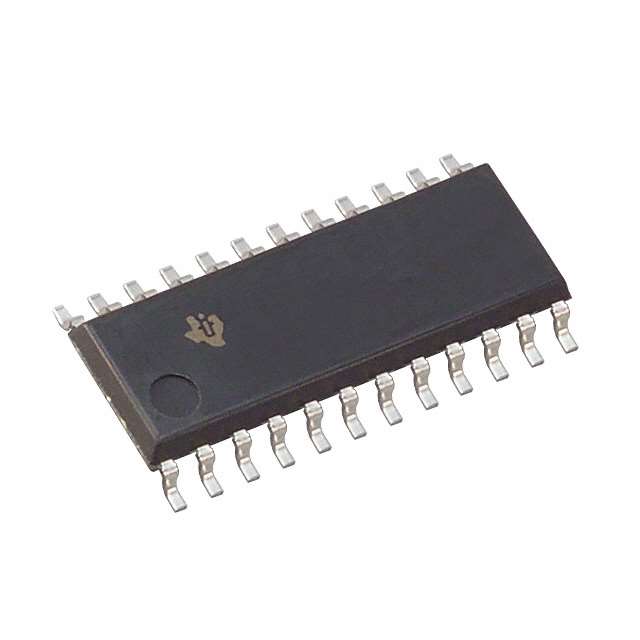Lihat spesifikasi untuk detail produk.

CD4067BNSR
Product Overview
- Category: Integrated Circuit (IC)
- Use: Multiplexer/Demultiplexer
- Characteristics: High-speed, low-power CMOS analog multiplexer/demultiplexer
- Package: 24-pin SOIC (Small Outline Integrated Circuit)
- Essence: CD4067BNSR is a versatile IC that allows for the selection of one input from multiple sources or the distribution of one input to multiple outputs. It is commonly used in various electronic applications.
- Packaging/Quantity: Available in reels with 2500 units per reel.
Specifications
- Supply Voltage Range: 3V to 20V
- On-State Resistance: 80Ω (typical)
- On-State Flatness: 5Ω (typical)
- Channel-to-Channel Crosstalk: -70dB (typical)
- Operating Temperature Range: -55°C to +125°C
Pin Configuration
The CD4067BNSR has a total of 24 pins arranged as follows:
- INHIBIT (INH)
- ENABLE (EN)
- SELECT A (SA)
- SELECT B (SB)
- SELECT C (SC)
- SELECT D (SD)
- COMMON OUT (COM)
- CHANNEL 0 (CH0)
- CHANNEL 1 (CH1)
- CHANNEL 2 (CH2)
- CHANNEL 3 (CH3)
- CHANNEL 4 (CH4)
- CHANNEL 5 (CH5)
- CHANNEL 6 (CH6)
- CHANNEL 7 (CH7)
- CHANNEL 8 (CH8)
- CHANNEL 9 (CH9)
- CHANNEL 10 (CH10)
- CHANNEL 11 (CH11)
- CHANNEL 12 (CH12)
- CHANNEL 13 (CH13)
- CHANNEL 14 (CH14)
- CHANNEL 15 (CH15)
- VCC (Supply Voltage)
Functional Features
- High-speed switching capability
- Low power consumption
- Wide supply voltage range
- Break-before-make switching action
- Built-in protection diodes for handling large input/output voltages
Advantages and Disadvantages
Advantages: - Versatile multiplexer/demultiplexer functionality - High-speed operation - Low power consumption - Wide supply voltage range allows for compatibility with various systems - Built-in protection diodes enhance reliability
Disadvantages: - Limited number of channels (16 in total) - On-state resistance may introduce some signal attenuation
Working Principles
The CD4067BNSR operates by utilizing a combination of analog switches to route signals between the input and output channels. The selection of the desired channel is controlled through the input pins (SA, SB, SC, SD). When a specific channel is selected, the corresponding input signal is connected to the common output pin (COM).
Detailed Application Field Plans
The CD4067BNSR finds applications in various fields, including but not limited to:
- Audio/Video Signal Routing: Used in audio/video equipment to switch between different sources or distribute signals to multiple outputs.
- Data Acquisition Systems: Enables the selection of different sensor inputs for data acquisition purposes.
- Communication Systems: Facilitates the routing of signals in communication systems, such as telecommunication networks.
- Industrial Automation: Allows for the control and monitoring of different sensors and actuators in industrial automation processes.
Detailed and Complete Alternative Models
Some alternative models that offer similar functionality to CD4067BNSR include:
- CD4051BNSR: 8-channel analog multiplexer/demultiplexer.
- CD4052BNSR: Dual 4-channel analog multiplexer/demultiplexer.
- CD4053BNSR: Triple 2-channel analog multiplexer/demultiplexer.
These alternative models provide different channel configurations to suit specific application requirements.
Word count: 410 words
Sebutkan 10 pertanyaan dan jawaban umum terkait penerapan CD4067BNSR dalam solusi teknis
Sure! Here are 10 common questions and answers related to the application of CD4067BNSR in technical solutions:
Q: What is CD4067BNSR? A: CD4067BNSR is a multiplexer/demultiplexer integrated circuit (IC) that allows multiple analog or digital signals to be routed through a single pin.
Q: What are the typical applications of CD4067BNSR? A: CD4067BNSR is commonly used in audio/video signal routing, data acquisition systems, analog-to-digital converters, and other applications where multiple signals need to be switched or multiplexed.
Q: How many channels does CD4067BNSR support? A: CD4067BNSR supports 16 channels, meaning it can handle up to 16 different input/output signals.
Q: What is the voltage range supported by CD4067BNSR? A: CD4067BNSR operates with a wide voltage range, typically from 3V to 18V.
Q: Can CD4067BNSR handle both analog and digital signals? A: Yes, CD4067BNSR can handle both analog and digital signals, making it versatile for various applications.
Q: How does CD4067BNSR select the desired channel? A: CD4067BNSR uses control pins to select the desired channel. By setting the appropriate combination of control signals, you can route the desired signal to the output pin.
Q: Is CD4067BNSR bidirectional? A: No, CD4067BNSR is unidirectional, meaning it can only route signals from input to output and not vice versa.
Q: What is the maximum frequency supported by CD4067BNSR? A: CD4067BNSR can handle frequencies up to several megahertz, making it suitable for many audio and video applications.
Q: Can CD4067BNSR be cascaded to increase the number of channels? A: Yes, multiple CD4067BNSR ICs can be cascaded together to increase the number of channels available.
Q: Are there any special considerations when using CD4067BNSR? A: It is important to ensure that the voltage levels of the signals being routed through CD4067BNSR are within its specified operating range. Additionally, proper decoupling capacitors should be used to minimize noise and ensure stable operation.
Please note that these answers are general and may vary depending on specific datasheet specifications and application requirements.

